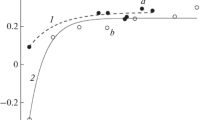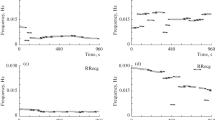Abstract
A concept of functional isolation of the heart from nervous effects as a mechanism of heart adaptation to extreme states has been formulated. In moderate hypoxia, isolation of the cardiovasomotor center from nonhypoxic afferention provides the compliance of myocardial hyperfunction to the intensity of hypoxia and limits heart participation in different forms of activity of the organism. In thermal hypoxia, myocardial isolation from sympathetic and parasympathetic effects ensures its minimal function and economy of energy due to transfer to the autorhythmical mode of function and rules out heart participation in circulatory reactions. Functional isolation of the heart in hypoxia is caused by energy deficiency and depends on the training of an organism and coordination of the sympathetic and parasympathetic effects. High prevalence of isolation of cells, organs, and systems from regulating effects in health and disease is demonstrated and its mechanisms, levels, and impact are disclosed. Both the “extension” of nervous bonds and hyperfunction and the “narrowing” of nervous bonds and hypofunction of biological systems are aimed at adaptation of an organism.
Similar content being viewed by others
References
P. K. Anokhin, in:The Problem of Center and Periphery in Nervous Activity [in Russian], Gorky (1935), pp. 9–70.
P. K. Anokhin,Essays on the Physiology of Functional Systems [in Russian], Moscow (1975).
E. P. Bilibin,Functional Deafferentation is a Typical Reaction of an Alterated Heart. An Experimental Study [in Russian], Abstr. DM Thesis, Moscow (1987).
A. Dorn,The Change of Function Principle [in Russian], Moscow-Leningrad (1937).
D. G. Krasnikov,Threatened Preterm Labor and Sympathoadrenal Function of Pregnant Women during Tocolythic Therapy [in Russian], Abstr. MD Thesis, Moscow (1986).
A. Lenindger,Biochemistry [in Russian], Moscow (1976).
N. I. Losev, N. K. Khitrov, and P. F. Litvitskii, in:Physiological Cybernetics [in Russian], Moscow (1981), pp. 90–94.
E. E. Matova, in:Manual of Cardiology [in Russian], Vol. 1, Moscow (1981), pp. 48–56.
S. E. Meyer, D. E. Dobson, W. R. Ingerbretsen,et al., in:Myocardial Metabolism [in Russian], Moscow (1979), pp. 37–53.
N. P. Napalkov and Ya. V. Bochman, in:General Oncology [in Russian], Leningrad (1989), pp. 156–168.
V. P. Nuzhnyi, N. K. Khitrov, and A. M. Alaverdyar,Fiziol. Zh. SSSR,63, No. 4, 439–444 (1977).
L. A. Orbeli,The Problem of Trophic Innervation and Its Relation to Neurosis Pathology (1956), in:Selected Works [in Russian], Vol. 4, Moscow-Leningrad (1966), pp. 245–256.
V. N. Polyakov,Adaptive Reactions of the Circulatory System during Autonomic Blocking and Acute Cardiac Stress [in Russian], Author's Synopsis of Cand. Med. Sci. Dissertation, Moscow (1985).
V. G. Popov, V. K. Lazutin, N. K. Khitrov,et al., Kardiologiya,14, No. 3, 29–35 (1974).
V. G. Popov, V. K. Lazutin, N. K. Khitrov,et al., —Ibid.,15, No. 10, 102–107 (1975).
T. E. Radzevich,Evoked Potentials as an Indicator of Cerebral Function at Different Stages of Hypoxia [in Russian], Author's Synopsis of Cand. Med. Sci. Dissertation, Moscow (1981).
A. B. Saltykov, A. V. Tolknov, and N. K. Khitrov,Behavior and Indefinite Environment. Mechanisms and Clinical Significance [in Russian], Moscow (1996).
V. P. Skulachev,Energy Transformation in Biological Membranes [in Russian], Moscow (1972).
V. G. Filimonov,Pathogenesis of Disorders of Uterine Contractility and Modern Views on the Compensatory Potential of the Organism in Gestation [in Russian], Author's Synopsis of Doct. Med. Sci. Dissertation, Moscow (1975).
N. K. Khitrov, in:Inflammation. Manual for Physicians [in Russian], eds. V. V. Serov and V. S. Paukov, Moscow (1995), pp. 262–286.
N. K. Khitrov and A. M. Alaverdyan,Kosm. Biol.,12, No. 2, 53–56 (1978).
N. K. Khitrov and A. M. Alaverdyan,Fiziol. Zh. SSSR,61, No. 2, 325–329 (1981).
N. K. Khitrov and E. A. Demurov, —Ibid.,59, No. 8, 1225–1230 (1973).
N. K. Khitrov, E. A. Demurov, and A. A. Abinder,Pat. Fiziol., No. 2, 80–88 (1971).
N. K. Khitrov and A. I. Ivanov,Kardiologiya,23, No. 1, 94–98 (1983).
N. K. Khitrov, V. V. Padalko, and E. A. Demurov,Pat. Fiziol., No. 4, 85–87 (1972).
N. K. Khitrov and V. S. Paukov,Heart Adaptation to Hypoxia [in Russian], Moscow (1991).
N. K. Khitrov, V. S. Paukov, and A. I. Svistukhin,Byull. Eksp. Biol. Med.,79, No. 6, 35–38 (1975).
N. K. Khitrov, V. G. Popov, V. B. Lazutin,et al., Pat. Fiziol., No. 1, 14–19 (1977).
N. K. Khitrov and A. I. Svistukhin, —Ibid., No. 2, 21–25 (1975).
N. K. Khitrov and A. I. Svistukhin,Byull. Eksp. Biol. Med.,87, No. 6, 523–525 (1979).
N. K. Khitrov, T. G. Sinel'nikova, and Kh. A. Musalatov,Stress, Behavioral Disorders, and Modern War [in Russian], Moscow (1992).
I. Foulds,Neoplastic Development, New York (1976).
K. Golwitzer-Meier, K. Kramer, and E. Kruger,Arch. Ges. Physiol.,237, No. 5, 639–650 (1936).
K. Golwitzer-Meier and C. Kroetz,Klin. Wochenschr.,19, No. 25, 616–620 (1940).
N. C. Khitrov, E. B. Tezikov, and S. V. Grachev, in:Stress. The Role of Catecholamines and Other Neurotransmitters, New York (1983), Vol. 1, pp. 295–307.
M. N. Levy,Circ. Res.,29, No. 5, 437–445 (1971).
K. Loffelhols and F. Muscholl,Naunyn Schmiedebergs Arch. Pharmacol.,258, No. 2, 108–122 (1967).
M. Schwegler and R. Yacob,Recent Adv. Stud. Cardiac Struct. Metab.,8, 391–399 (1976).
H. Thoenen, in:Neurotransmitters and Metabolism Regulation, London (1972), pp. 3–15.
M. Vassalle, W. I. Mandel, and M. S. Holder,Am. J. Physiol.,218, No. 1, 115–123 (1970).
Author information
Authors and Affiliations
Additional information
Translated fromByulleten' Eksperimental'noi Biologii i Meditsiny, Vol. 125, No. 6, pp. 604–611, June, 1998
Rights and permissions
About this article
Cite this article
Khitrov, N.K. Isolation from nervous effects: A mechanism of adaptation of biological systems to disease. Bull Exp Biol Med 125, 533–539 (1998). https://doi.org/10.1007/BF02445231
Received:
Issue Date:
DOI: https://doi.org/10.1007/BF02445231




